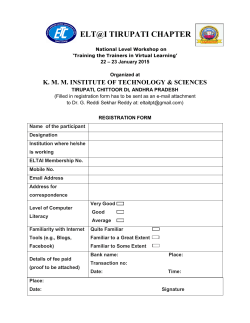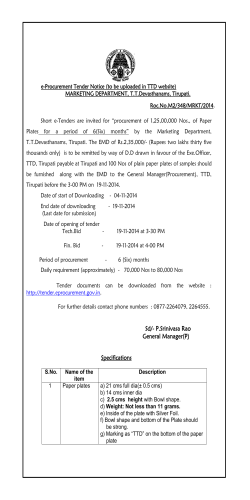
PHYTOCHEMICAL INVESTIGATION OF AQUEOUS FRUIT
Indian Journal of Plant Sciences ISSN: 2319–3824(Online) An Open Access, Online International Journal Available at http://www.cibtech.org/jps.htm 2015 Vol.4 (1) January-March, pp.11-15/Bharathamma and Sudarsanam Research Article PHYTOCHEMICAL INVESTIGATION OF AQUEOUS FRUIT EXTRACTS OF DREGEA VOLUBILIS (LINN.) BENTH *Bharathamma G. and Sudarsanam G. Department of Botany, SVUCS, Sri Venkateswara University, Tirupati 517502, Andhra Pradesh, India *Author for Correspondence ABSTRACT Dregea volubilis (Linn.) Benth. (Asclepiadaceae) has been used in traditional and Ayurvedic system of medicine for healing various diseases like general debility alternate, refrigerant, skin diseases and haemorrhoids. The present study was aimed to evaluate the medicinal valued biomolecules in the aqueous extracts of fruit of Dregea volubilis. Results claim the presence of Alkaloids, Terpenoids, Steroids, Coumarins, Tannins, Flavonoids, Proteins, Carbohydrates, Glycosides, Phytosterol, Anthocyanidins, Amino acids, Phenolic compounds Lipids and certain unidentified compounds. Our investigation revealed that Dregea volubilis is an important source of many therapeutically and pharmacologically active medicinally potent biochemical constituents. Keywords: Dregea volubilis, Aqueous Extract, Phytochemical Analysis. INTRODUCTION In modern medicine also, plants occupy a very significant place as raw material for some important drugs although synthetic drugs and antibiotics have brought about a revolution in controlling different diseases. Plants used in traditional system of medicine of pharmaceutical houses in collected from wild sources (Singh, 2003). Medicinal plants are the richest bioresource of drugs of traditional system of medicines, pharmaceutical intermediates and chemical entities for synthetic drugs (Ncube et al., 2008). Medicinal plants form a large group of economically important plants that provide the basic raw materials for indigenous pharmaceuticals (Aiyelaagloe, 2001). According to the WHO the first step for identification and purification of herbal drugs is the pharmacognostic (macroscopic and microscopic) studies which are essential for any phytopharmaceutical products were used for standard formulation (WHO, 1998). Preliminary phytochemical studies are helpful in finding out chemical constituents in the plant material that may well lead to their quantitative estimation (Raiv et al., 2013; Lamaeswari and Ananti, 2012). Phytochemicals are used as templates for lead optimization programs, which are intended to make safe and effective drugs (Balunas, 2005). Hence, it is desirable to know the phytochemical composition of the plant material before testing its efficacy for medicinal purpose. Dregea volubilis (Linn.) Benth. is an important medicinal twinning glabours perennial herb belonging to family Asclepiadaceae. The main aim of the present research was to study the phytochemical studies of fruit of Dregea volubilis. The whole plants are extensively used in indigenous system of medicine. The whole plant used for general debility (Madhava chetty et al., 2013). The concentrations of the bioactive compounds in different parts of the plant have not been investigated and this is needed to guide users in targeting the fruit with the highest concentration for therapeutic and pharmacognostic uses. MATERIALS AND METHODS The plant of Dregea volubilis matured fruits was collected during the month of April from wild in different localities of in and around the Tirupati. The botanical identification of the taxa was carried out by using regional and local floras (Gamble, 1957; Madhava et al., 2013). The herbarium was prepared according to the method of Jain and Rao (1977) and deposited in the Department of Botany, Sri Venkateswara University, Tirupati, Andhra Pradesh for further use. The voucher specimen was authenticated by Prof.N.Yasodamma, Plant taxonomist, SV University,Tirupati. © Copyright 2014 | Centre for Info Bio Technology (CIBTech) 11 Indian Journal of Plant Sciences ISSN: 2319–3824(Online) An Open Access, Online International Journal Available at http://www.cibtech.org/jps.htm 2015 Vol.4 (1) January-March, pp.11-15/Bharathamma and Sudarsanam Research Article Phytochemical Analysis Fruits (500gms) collected was shade dried and made into coarse powder and made into extract. The aqueous extract was prepared by cold maceration technique. Then the extracts were collected, concentrated using rotary vacuum evaporator. The extracts were filtered using Whatmann filtered paper no. 42 (125 mm) (Sigma-Aldrich). The Aqueous fruit extract was subjected to different chemical tests for the detection of different phytoconstituents using standard procedures (Harborne, 1973; Ibrahim and Towers, 1960; Daschowdary et al., 1967; Markham, 1982; Gibbs, 1974; Edeoga et al., 2005). Terpenoids by Libermann-Burchand test and steroids by Salkowski test. Coumarin test, Tannin test, Flavonoids test, Proteins test (Millions test), Carbohydrate test (Molish test), Test for glycosides, Phytosterol test, Anthocyanidin test, test for amino acids were done. Figure A: Habit Figure B: Fruiting stage RESULTS AND DISCUSSION Table 1: Preliminary qualitative phytochemical analysis Name of the test Alkaloids Terpenoids Steroids Coumarins Tannins Flavonoids Proteins Carbohydrates Glycosides Phytosterol Lipids Anthocyanidins Amino acids + Present; - Absent Dregea volubilis + + + + + + + + + + + + + Phytochemical Analysis The aqueous fruit extract of Dregea volubilis were subjected to various qualitative tests for the identification of phytochemical constituents are tabulated in Table-1-6. Preliminary phytochemical screening of the Fruit aqueous extract of Dregea volubilis revealed the presence of major bioactive compounds which may retain a wide range of pharmaceutical and © Copyright 2014 | Centre for Info Bio Technology (CIBTech) 12 Indian Journal of Plant Sciences ISSN: 2319–3824(Online) An Open Access, Online International Journal Available at http://www.cibtech.org/jps.htm 2015 Vol.4 (1) January-March, pp.11-15/Bharathamma and Sudarsanam Research Article therapeutical action The fruits of Dregea volubilis contain majority of metabolites except saponins, quinines, anthroquinones. Alkaloids, Terpenoids, Steroids, Coumarins, Tannins, Flavonoids, Proteins, Phenolic compounds, Carbohydrates, Glycosides, Starch, Phytosterol, Lipids, Anthocyanidins, Amino acids and Lignins are known to be of therapeutic importance since they have biological roles (Jonsen et al., 1987). In Table-4 shows presence of phenolic compounds in Dregea volubilis. Table 2: Qualitative analysis of anthocyanidins detected Compound Delphinidin Petunidin Malvidin Peonidin + Present; - Absent Table 3: Qualitative analysis of flavonoid compounds detected Compound Rutin Myricetin Quercetin Kaempferol Luteolin Apigenin Orientin Vitexin + Present; - Absent Table 4: Qualitative analysis of phenolic compounds detected Compound Caffeic acid Protocatechuic acid Chlorogenic acid Iso-Chlorogenic acid homo-Protocatechuic acid Gentisic acid -Resorcylic acid -Resorcylic acid cis-p-Coumaric acid trans-p-Coumaric acid p-Hydroxybenzoic acid Phloretic acid cis-Ferulic acid Scopoletin Aesculetin cis-Sinapic acid trans-Sinapic acid Vanillic acid Syringic acid Coumarin Salicylic acid Cinnamic acid + Present; - Absent © Copyright 2014 | Centre for Info Bio Technology (CIBTech) Dregea volubilis + + Dregea volubilis + + + + + + Dregea volubilis + + + + + + + + + + + + + + + + + + 13 Indian Journal of Plant Sciences ISSN: 2319–3824(Online) An Open Access, Online International Journal Available at http://www.cibtech.org/jps.htm 2015 Vol.4 (1) January-March, pp.11-15/Bharathamma and Sudarsanam Research Article Table 5: Qualitative analysis of amino acids detected Compound Aspartic acid Arginine Asparagine -Alanine -Alanine 2-Amino butyric acid Cysteine Cystine Glutamic acid Glutamine Glycine Histidine Isoleucine Leucine Lysine -Methylene glutamic acid -Methylene glutamine Ornithine Phenylalanine Proline Serine Threonine Tyrosine Valine + Present; - Absent Table 6: Quantitative analysis of lipids detected Compound Phosphatidic acid Phosphatidyl serine Phosphatidyl inositol Phosphatidyl choline Phosphatidyl ethanolamine Digalactosyl diglyceride Phosphatidyl glycerol Unidentified galactolipid Sulphoquinovosyl diglyceride Diphosphatidyl glycerol Steryl glucoside Monogalactosyl diglyceride Steryl glycoside + Present; - Absent Dregea volubilis + + + + + + + + + + + + + + + + + + Dregea volubilis + + + + + + + + + + + + Conclusion In the present paper, we aim to achieve a study referring to the qualitative and quantitative chemical composition of fruits of Dregea volubilis. The fruit contains different secondary metabolites viz., Anthocyanidins (Delphinidin, Petunidin), Flavonoids (Rutin, Myricetin, Quercetin, Luteolin, Apigenin, © Copyright 2014 | Centre for Info Bio Technology (CIBTech) 14 Indian Journal of Plant Sciences ISSN: 2319–3824(Online) An Open Access, Online International Journal Available at http://www.cibtech.org/jps.htm 2015 Vol.4 (1) January-March, pp.11-15/Bharathamma and Sudarsanam Research Article Orientin, unidentified flavonoid), Phenolic compounds (iso-chlorogenic acid, caffeic acid, Gentisic acid, β-Resorcyclic acid, cis-p-coumaric acid, vanillic acid, cinnamic acid. Results of phytochemical evaluation revealed the presence of alkaloids, Terpenoids, Steroids, Coumarins, Tannins, Proteins, Phenolic compounds, Carbohydrates, Glycosides, Starch, Phytosterol, Lipids, Aminoacids, Lignins. This could be the crucial step in further studies on the phytochemical, biological structure function relationship of the study plant which is already reported to be of therapeutic importance. This established a significant scope to develop a broad spectrum use of Dregea volubilis in herbal medicine and as a base for the development of revel potent drug and phytomedicine. REFERENCES Aiyelaagbe O (2001). Antibacterial activity of Jatropa multifida roots. Fitoterapia 72 544-546. Asquish TN and Butler LG (1986). Interactions of of condensed tannins with selected proteins. Phytochemistry 25(7) 1591-1953. Balunas MJ and Kinghorn AD (2005). During discovery from Medicinal Plants. Life Sciences 78(5) 431-441. Bhattacharjee SK (2003). Handbook of Medicinal Plants, 5 edition (Pointer Publishers) Jaipur. Edeoga HO, Okwu DE and Mbaobie BO (2005). Phytochemical Constituents of some Ingrain Medicinal Plants. African Journal of Biotechnology 4(7) 685-688. Gamble JS (1957). Flora of the Presidency of Madras (BSI) Calculatta 1-13. Gibbs RD (1974). Chemotaxonomy of Flowering Plants (Mc Gill Queen’s University Press) London 1-4. Harborne JB (1973). Phytochemical methods. A Guide to Modern Techniques of Plant Analysis (Chapmen and Hall) London. Jain SK and Rao RR (1977). A Hand Book of Field and Herbarium Methods (Today & Tomorrow’s Printers and Publishers) New Delhi A53-A55. Jonsen AM, Cheffer JJC and Svendsen AB (1987). Antimicrobial activity of essential oils: a 1976-86 literature review, Aspects of test methods. Plant Medicine 40 395-398. Lamaeswari G and Ananti T (2012). Preliminary Phytochemical Screening and Physicochemical Characterization of Canna indica L. International Journal of Pharmaceutical Science Review and Research 14 76-79. Madhava Chetty K, Sivaji K and Tulasi Rao K (2013). Flowering plants of Chittoor District, Andhra Pradesh, India, 3rd edition (Students Offset Printers) Tirupati. Ncube NS, Afolayan AJ and Okoh AL (2008). Assessment techniques of antimicrobial properties of natural compounds of plant origin: Current Methods and Future Trends. African Journal of Biotechnology 7 1797-1806. Poornima V and Hosanath (2011). Evaluation of Antibacterial activity of Listea glutinosa. International Journal of Pharmaceutical Applications 2(1) 105-114. Rai VM, Pai VR, Kedilaya PH and Hegde S (2013). Preliminary Phytochemical Screening of members of Lamiaceae family: Leucas linifolia, coleus aromaticus and Pogestemon patchouli. International Journal of Pharmaceutical Science Review and Research 21(1) 131-137. Singh MP, Srivastava J and Pandey SN (2003). Indigenous Medicinal Plants, Social Forestry, and Tribals. In: Forests and Forestry (Daya Publishing House) New Delhi 505. WHO (1998). Quality Control methods for herbal materials, updated edition of Quality Control methods for Medicinal Plant Materials. © Copyright 2014 | Centre for Info Bio Technology (CIBTech) 15
© Copyright 2025










